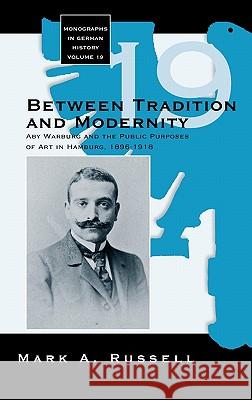Between Tradition and Modernity: Aby Warburg and the Public Purposes of Art in Hamburg » książka
Between Tradition and Modernity: Aby Warburg and the Public Purposes of Art in Hamburg
ISBN-13: 9781845453695 / Angielski / Twarda / 2007 / 272 str.
"Russell clearly succeeds in erasing historically one-dimensional views of Hamburg's late entry into shaping Germany's larger cultural and intellectual discourse." - German Studies Review ..".a valuable scholarly contribution, serving as a useful reminder of the broad spectrum of political views and levels of engagement to be found in the complex confrontations with modernity in later imperial Germany." - The American Historical Review ..". a compelling and needed nuance to overly simplified assumptions about Wilhelmine history. Russell) offers instead a Hamburg that used its public art both to understand its unique history and to embrace a new path for the future...Russell's writing is clear and readable.. he is able to add a significant contribution to the scholarship on Hamburg by moving beyond its role as a commercial hub within the empire and adding to its credence as a center of shaping the definition of a Kulturstadt." - H-Net "This scholarly and highly nuanced book will be an invaluable source for art historians as well as those studying twentieth-century Germany and its political, cultural, intellectual and emotional history." - Notable Book Reviews "This is real interdisciplinary work of the highest quality." - Jonathan Steinberg, Walter H. Annenberg Professor of Modern European History, University of Pennsylvania Aby Warburg (1866-1929), founder of the Warburg Institute, was one of the most influential cultural historians of the twentieth century. Focusing on the period 1896-1918, this is the first in-depth, book-length study of his response to German political, social and cultural modernism. It analyses Warburg's response to the effects of these phenomena through a study of his involvement with the creation of some of the most important public artworks in Germany. Using a wide array of archival sources, including many of his unpublished working papers and much of his correspondence, the author demonstrates that Warburg's thinking on contemporary art was the product of two important influences: his engagement with Hamburg's civic affairs and his affinity with influential reform movements seeking a greater role for the middle classes in the political, social and cultural leadership of the nation. Thus a lively picture of Hamburg's cultural life emerges as it responded to artistic modernism, animated by private initiative and public discourse, and charged with debate.
"Russell clearly succeeds in erasing historically one-dimensional views of Hamburgs late entry into shaping Germanys larger cultural and intellectual discourse." · German Studies Review"...a valuable scholarly contribution, serving as a useful reminder of the broad spectrum of political views and levels of engagement to be found in the complex confrontations with modernity in later imperial Germany." · The American Historical Review"... a compelling and needed nuance to overly simplified assumptions about Wilhelmine history. [Russell) offers instead a Hamburg that used its public art both to understand its unique history and to embrace a new path for the future...Russells writing is clear and readable.. he is able to add a significant contribution to the scholarship on Hamburg by moving beyond its role as a commercial hub within the empire and adding to its credence as a center of shaping the definition of a Kulturstadt." · H-Net"This scholarly and highly nuanced book will be an invaluable source for art historians as well as those studying twentieth-century Germany and its political, cultural, intellectual and emotional history." · Notable Book Reviews"This is real interdisciplinary work of the highest quality." · Jonathan Steinberg, Walter H. Annenberg Professor of Modern European History, University of PennsylvaniaAby Warburg (1866-1929), founder of the Warburg Institute, was one of the most influential cultural historians of the twentieth century. Focusing on the period 1896-1918, this is the first in-depth, book-length study of his response to German political, social and cultural modernism. It analyses Warburgs response to the effects of these phenomena through a study of his involvement with the creation of some of the most important public artworks in Germany. Using a wide array of archival sources, including many of his unpublished working papers and much of his correspondence, the author demonstrates that Warburgs thinking on contemporary art was the product of two important influences: his engagement with Hamburgs civic affairs and his affinity with influential reform movements seeking a greater role for the middle classes in the political, social and cultural leadership of the nation. Thus a lively picture of Hamburgs cultural life emerges as it responded to artistic modernism, animated by private initiative and public discourse, and charged with debate.











